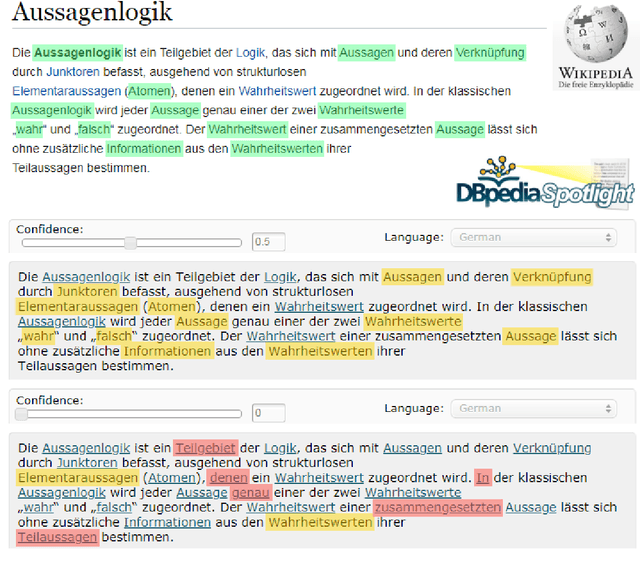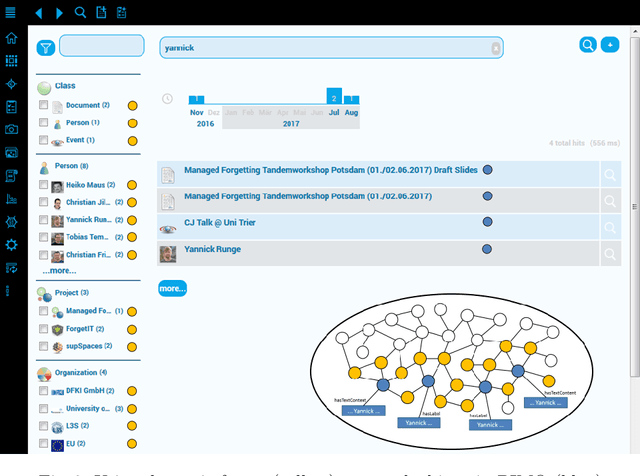Sven Schwarz
Towards Self-organizing Personal Knowledge Assistants in Evolving Corporate Memories
Aug 03, 2023Abstract:This paper presents a retrospective overview of a decade of research in our department towards self-organizing personal knowledge assistants in evolving corporate memories. Our research is typically inspired by real-world problems and often conducted in interdisciplinary collaborations with research and industry partners. We summarize past experiments and results comprising topics like various ways of knowledge graph construction in corporate and personal settings, Managed Forgetting and (Self-organizing) Context Spaces as a novel approach to Personal Information Management (PIM) and knowledge work support. Past results are complemented by an overview of related work and some of our latest findings not published so far. Last, we give an overview of our related industry use cases including a detailed look into CoMem, a Corporate Memory based on our presented research already in productive use and providing challenges for further research. Many contributions are only first steps in new directions with still a lot of untapped potential, especially with regard to further increasing the automation in PIM and knowledge work support.
Inflection-Tolerant Ontology-Based Named Entity Recognition for Real-Time Applications
Dec 05, 2018



Abstract:A growing number of applications users daily interact with have to operate in (near) real-time: chatbots, digital companions, knowledge work support systems -- just to name a few. To perform the services desired by the user, these systems have to analyze user activity logs or explicit user input extremely fast. In particular, text content (e.g. in form of text snippets) needs to be processed in an information extraction task. Regarding the aforementioned temporal requirements, this has to be accomplished in just a few milliseconds, which limits the number of methods that can be applied. Practically, only very fast methods remain, which on the other hand deliver worse results than slower but more sophisticated Natural Language Processing (NLP) pipelines. In this paper, we investigate and propose methods for real-time capable Named Entity Recognition (NER). As a first improvement step we address are word variations induced by inflection, for example present in the German language. Our approach is ontology-based and makes use of several language information sources like Wiktionary. We evaluated it using the German Wikipedia (about 9.4B characters), for which the whole NER process took considerably less than an hour. Since precision and recall are higher than with comparably fast methods, we conclude that the quality gap between high speed methods and sophisticated NLP pipelines can be narrowed a bit more without losing too much runtime performance.
Advanced Memory Buoyancy for Forgetful Information Systems
Nov 17, 2018



Abstract:Knowledge workers face an ever increasing flood of information in their daily lives. To counter this and provide better support for information management and knowledge work in general, we have been investigating solutions inspired by human forgetting since 2013. These solutions are based on Semantic Desktop (SD) and Managed Forgetting (MF) technology. A key concept of the latter is the so-called Memory Buoyancy (MB), which is intended to represent an information item's current value for the user and allows to employ forgetting mechanisms. The SD thus continuously performs information value assessment updating MB and triggering respective MF measures. We extended an SD-based organizational memory system, which we have been using in daily work for over seven years now, with MF mechanisms directly embedding them in daily activities, too, and enabling us to test and optimize them in real-world scenarios. In this paper, we first present our initial version of MB and discuss success and failure stories we have been experiencing with it during three years of practical usage. We learned from cognitive psychology that our previous research on context can be beneficial for MF. Thus, we created an advanced MB version especially taking user context, and in particular context switches, into account. These enhancements as well as a first prototypical implementation are presented, too.
Context Spaces as the Cornerstone of a Near-Transparent & Self-Reorganizing Semantic Desktop
May 06, 2018

Abstract:Existing Semantic Desktops are still reproached for being too complicated to use or not scaling well. Besides, a real "killer app" is still missing. In this paper, we present a new prototype inspired by NEPOMUK and its successors having a semantic graph and ontologies as its basis. In addition, we introduce the idea of context spaces that users can directly interact with and work on. To make them available in all applications without further ado, the system is transparently integrated using mostly standard protocols complemented by a sidebar for advanced features. By exploiting collected context information and applying Managed Forgetting features (like hiding, condensation or deletion), the system is able to dynamically reorganize itself, which also includes a kind of tidy-up-itself functionality. We therefore expect it to be more scalable while providing new levels of user support. An early prototype has been implemented and is presented in this demo.
* 5 pages, 2 figures (high-res versions in attachments), 1 demo video (in attachments)
 Add to Chrome
Add to Chrome Add to Firefox
Add to Firefox Add to Edge
Add to Edge